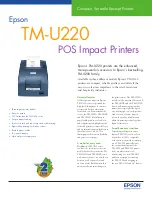
14 |
ß
Back to CONTENTS
ß
Back to CONTENTS
| 15
Your transactions
must be “settled”
daily. Read this
section to ensure the
settlement process
operates smoothly.
SETTLING THE BATCH
ABOUT SETTLEMENT
A Settlement operation is used to close the current batch and
open a new batch for logging and accumulating transactions.
Your VeriFone terminal uses a Host Capture System (HCS),
meaning all transaction information is sent to and stored by the
host (Chase Paymentech) at the time of sale.
There are three settlement options: Manual Settlement,
Auto Settlement and Host Auto Settlement.
1 - MANUAL SETTLEMENT
If your terminal is set to manually settle, select
Settlement
from the main menu and follow the prompts displayed.
2 - AUTO SETTLEMENT
If your terminal is set to automatically settle, it will automatically
settle transactions in the current batch at a specific,
predetermined time, within a 24-hour period. When configured,
auto settlement begins any time after the set time occurs if there
are transactions in the batch, and the terminal will print
settlement reports upon completion.
For example, if auto settlement time is set to 22:30:00
(10:30 p.m.) then auto settlement occurs any time after
22:30:00. If the terminal is turned off before the set time,
and turned on again (usually the next morning), auto settlement
occurs at that time.
3 - HOST AUTO SETTLEMENT
Host Auto Settlement is a feature that must be selected either at
the time of initial terminal setup or must be set up by a Chase
Paymentech representative. If this feature is enabled, the
terminal will automatically settle transactions in the current batch
at 05:00:00 (5:00 a.m.) EST and will not print settlement reports
upon completion.
PROMPT Q&A
While navigating
through transactions,
you’ll find that some
prompts aren’t as
clear as others.
This section clarifies
those prompts.
PROMPT
DESCRIPTION/ACTION
1= [Merchant 1]
Prev [F1]
Next [F2]
Slct [F3]
Exit [F4]
Displayed when more
than one merchant is
programmed into your
terminal. Scroll to your
merchant name using the
[F]
keys to the right of the
display, and press
[ENTER]
.
Web Sale
Encrypted?
Yes [F1]
No [F2]
May display while
performing a web sale.
Select
Yes
or
No
in regard to
whether the card number
was collected via encrypted
means (such as, HTTPS
web page, PGP e-mail, etc.).
Imprint Card
Press Enter Key
May display while
performing a manually
entered transaction. Imprint
the card using a manual
imprint machine to prove
the card was present during
the transaction.
V-Code:
Enter the CVC (card
verification code), typically
the last 3 or 4 digits found
on the back of the card
on the signature line. CVC
codes are designed to
reduce payment card fraud.
Code Present?
No [F1]
Xread [F2]
Displays if V-Code prompt
is bypassed. Select
Xread
if the code is present,
but unreadable.




























